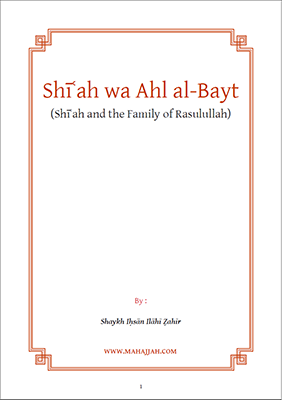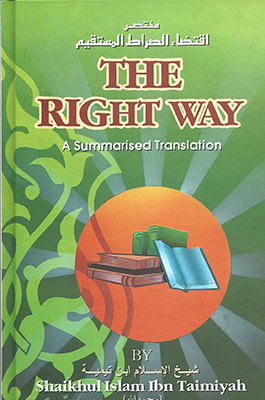Latest Lectures
Description
Division and differences among this ummah is something inevitable, to which history bears witness, as do the texts of the Sunnah of our Prophet Muhammad (صلى الله عليه وسلم).
The Prophet (صلى الله عليه وسلم) said:
Whoever among you lives after I am gone will see a great deal of dissent.
Narrated by Abu Dawood (4067); classed as saheeh by al-Albaani in Saheeh Abi Dawood.
Dissent has occurred in the political field, as well as in the fields of thought and ‘aqeedah, which is represented in the appearance of different sects at the end of the era of the Rightly-Guided Caliphs, such as the Murji’is, Shi’ah and Khawaarij.
But by His mercy, Allaah decreed that this division should happen when some groups drifted away from the way of the main body of the Muslims and developed their own different approach, and they were distinguished by their own names and character. So the ‘aqeedah of Ahl al-Sunnah wa’l-Jamaa’ah, and the ‘aqeedah of the majority of Muslims, was not confused even for a day with that of the other, misguided sects, so that those sects would not dare to call themselves Ahl al-Sunnah wa’l-Jamaa’ah, rather they are called after the bid’ah (innovation) that they introduced, or the person who founded the sect. You can see that when you examine the names of all the sects.
The famous hadeeth about the ummah splitting into seventy-three sects bears witness to that.
It was narrated from Mu’aawiyah ibn Abi Sufyaan (رضي الله عنه) that he said: The Messenger of Allaah (صلى الله عليه وسلم) stood among us and said:
Those who came before you of the people of the Book split into seventy-two sects, and this ummah will split into seventy-three: seventy-two in Hell and one in Paradise, and that is the jamaa’ah (main body of Muslims).
Narrated by Abu Dawood (4597) and others; classed as saheeh by al-Haakim (1/128), who said: 'it is an important hadeeth that represents a basic principle'. It was classed as hasan by Ibn Hajar in Takhreej al-Kashshaaf (63). It was classed as saheeh by Ibn Taymiyah in Majmoo’ al-Fataawa (3/345), al-Shaatibi in al-I’tisaam (1/430), and al-‘Iraaqi in Takhreej al-Ihya’ (9/133). It is mentioned frequently and often quoted as evidence by the scholars in the books of Sunnah, and it was narrated from a number of the Sahaabah via many isnaads, most of the soundest of which specify the number of sects as being seventy-three.
The Prophet (صلى الله عليه وسلم) described the saved group as the jamaa’ah, i.e., the consensus of the Muslim scholars. In other reports he also described them as “the vast multitude”, as in the hadeeth of Abu Umaamah and others which is recorded by Ibn Abi ‘Aasim in al-Sunnah (1/34) and al-Tabaraani in al-Mu’jam al-Kabeer (8/321), with an isnaad that is hasan li ghayrihi (hasan because of corroborating evidence).
The Prophet (صلى الله عليه وسلم) also described them in the following terms:
“My ummah will split into seventy-three sects, all of whom will be in Hell except one group.” They said: Who are they, O Messenger of Allaah? He said: “(Those who follow) that which I and my companions follow.”
This is mentioned in the hadeeth of ‘Abd-Allaah ibn ‘Amr which was recorded and classed as hasan by al-Tirmidhi (2641). It was also classed as hasan by al-‘Iraaqi in Ahkaam al-Qur’aan (3/432), al-‘Iraaqi in Takhreej al-Ihya’ (3/284) and al-Albaani in Saheeh al-Tirmidhi.
This is the clearest sign that the Muslim can use to determine what is the saved group, so he should follow the way of the majority of scholars, those whom all the people testify are trustworthy and religiously-committed, and he should follow the way of the earlier scholars among the Sahaabah, Taabi’een and the four Imams and other scholars, and he should beware of every sect that differs from the main body of Muslims (jamaa’ah) by following innovation (bid’ah).
Shaykh al-Islam Ibn Taymiyah (may Allaah have mercy on him) said:
The sign of the people of bid’ah is that they do not follow the salaf.
Majmoo’ al-Fataawa (4/155).
He also said (3/346):
The sign of these groups – i.e., the seventy-two groups that go against Ahl al-Sunnah wa’l-Jamaa’ah – is that they forsake the Qur’aan, Sunnah and scholarly consensus. The one who follows the Qur’aan, Sunnah and scholarly consensus is one of Ahl al-Sunnah wa’l-Jamaa’ah.
It is not permissible for anyone to imagine after this that the Shi’ah, for example, are the saved group, or that the deviant Sufis, Khawaarij or Habashis are the saved group. Rather these are innovated groups which only follow invented ideas, that are denounced by the scholars and the majority of Muslims, who feel repulsion in their hearts towards them. Their ideas were never believed in for a day by Abu Bakr, ‘Umar, ‘Uthmaan or ‘Ali (رضي الله عنهم), or by Imam Abu Haneefah, Maalik, al-Shaafa’i or Ahmad ibn Hanbal. Would any wise person think that a belief that these imams were unaware of could be correct?
Think about it. There is the greatest and most obvious difference between Ahl al-Sunnah wa’l-Jamaa’ah (the saved group) and other, misguided groups.
Ibn Taymiyah (may Allaah have mercy on him) says:
Hence the saved group is described as Ahl al-Sunnah wa’l-Jamaa’ah, and they are the greater majority and the vast multitude. As for the other groups, they are followers of weird ideas, division, innovation and whims and desires, and none of these groups reached anywhere close to the size of the saved group, let alone being equal to them, rather some of these groups are very small in number. The sign of these groups is that they go against the Qur'aan, Sunnah and scholarly consensus. The one who follows the Qur’aan, Sunnah and scholarly consensus is one of Ahl al-Sunnah wa’l-Jamaa’ah.
Majmoo’ al-Fataawa (3/346).
- Shaykh Salih al-Munajjid

















